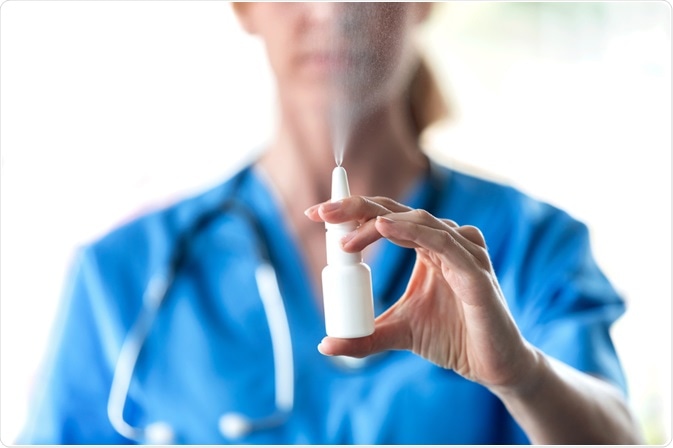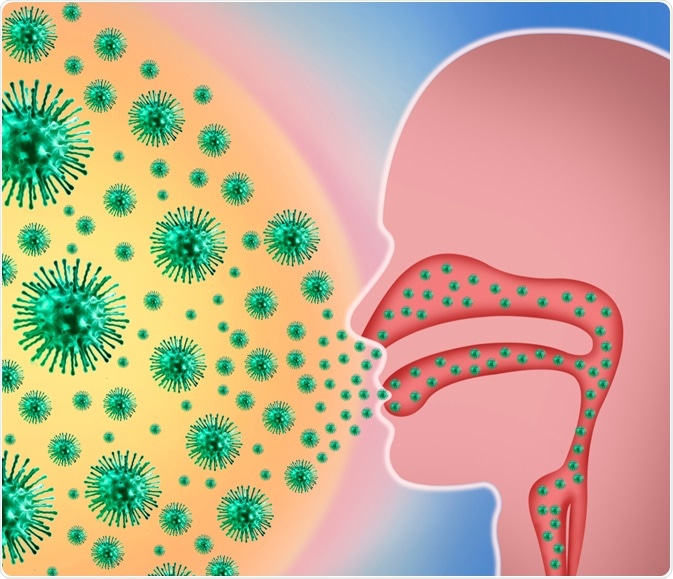High loads of the severe acute respiratory coronavirus 2 (SARS-CoV-2) are shed from the nasal cavity of infected individuals both pre-symptom and post-symptom onset, including from asymptomatic individuals. Disinfecting the nasal cavity of those who do or do not already suffer from COVID-19 may help to lessen contagiousness or act as a preventative, respectively.
Numerous nasal disinfectants are available, many of which are specifically intended to combat a particular infection. Cegolon et al. (2020) performed a thorough review of published literature from the last decade to scrutinize 8 different types of nasal disinfectants as a COVID-19 preventative agent, taking into account the mechanism of action, toxicity, and in vivo and in vitro evidence against similar viruses. Some of these potential preventative disinfectants will be discussed in detail below.
 Nasal disinfectants have been researched as a method of preventing SARS-CoV-2 infection. Image Credit: Josep Suria/Shutterstock.com
Nasal disinfectants have been researched as a method of preventing SARS-CoV-2 infection. Image Credit: Josep Suria/Shutterstock.com
Nasal disinfectants for consideration
Lactoperoxidase
Lactoperoxidase is an enzyme that is secreted from various mucosal glands and acts as a natural antimicrobial agent. In the presence of iodide (I-) or thiocyanate (SCN-) ions, lactoperoxidase catalyzes the formation of water from hydrogen peroxide, producing iodite (OI-) or hypothiocyanite (OSCN-) ions.
These ions interfere with respiration, glycolysis, and respiration in bacteria by forming strong bonds with thiol-bearing molecules and disrupting production pathways. Similarly, evidence shows that the surface proteins of various viruses can be disrupted and damaged by these ions and this may hamper the formation of other viral proteins and nucleic acids.
Interestingly, the combination of lactoperoxidase enzyme with hydrogen peroxide and iodide or thiocyanate is demonstrably more effective as an antimicrobial agent than the major products, iodite or hypothiocyanite ions, alone. This is possibly due to the production of more reactive intermediates that have not yet been detected. Regardless, the combination is currently used in toothpaste and mouthwash to good effect, and could potentially be quickly deployed as a COVID-19 preventative.
Lactoferrin
Lactoferrin is another protein that is naturally secreted in various bodily fluids, including saliva, tears, and mucus to act as an antimicrobial agent. Lactoferrin binds to proteoglycans on the surface of host cells to prevent contact between the cell and pathogens, preventing the virus from entering the cell.
A study undertaken by Serrano et al. (2020) aimed to demonstrate lessened symptoms in COVID-19 patients by lactoferrin and zinc supplementation, though the study is marred by sponsorship from interested parties. Nonetheless, lactoferrin does show good antiviral activity against various RNA- and DNA-based viruses in other studies and is currently given as an oral supplement to infants in some cases, so could potentially be employed as a COVID-19 preventative.
Interferons
Interferons are signaling proteins that are released by infected cells, priming neighboring cells to defend against the virus. Interferon-α nasal sprays have been shown to be effective against SARS-like coronavirus infections in in vitro tests in 2006, and animal tests have shown efficacy in blocking or reducing SARS-CoV-1 infection.
Interestingly, SARS-CoV-2 has been shown to inhibit the natural secretion of interferon from host cells, making exogenous supplementation an attractive prospect. In a 2020 study currently in preprint and therefore not yet peer-reviewed, around 3000 Chinese front-line medical workers were administered with recombinant human interferon-α on a daily basis in the form of nasal drops for a period of 28 days, with none acquiring any SARS-CoV-2 infections during the period. This study, however, makes any comparison with a control difficult, and so the results must be confirmed by additional studies. Additionally, interferon-α is relatively expensive and so is unlikely to be considered as a preventative for anyone but front line workers.
 Illustration of SARS-CoV-2 particles being inhaled. Image Credit: ilusmedical/Shutterstock.com
Illustration of SARS-CoV-2 particles being inhaled. Image Credit: ilusmedical/Shutterstock.com
Povidone-iodine
Povidone-iodine is a disinfectant that has been applied to the skin and small wounds of patients for decades, most commonly seen to be used before and after surgery thanks to its slow rate of adsorption. In a paper by Bidra et al. (2020) ordinarily orally administered polyvinylpyrrolidone-iodine at concentrations of 0.5% to 1.5% was applied to SARS-CoV-2 in vitro, with all concentrations demonstrating complete viricidal activity within 15 seconds.
As a nasal spray, the chemical is currently undergoing stage III clinical trials for the treatment of the common cold, which could have significant applications to COVID-19. However, toxicity remains a mild concern, as currently pregnant women and those with thyroid issues are recommended against use. Should it prove an effective preventative, however, it is widely available and relatively cheap to produce.
Alcohols
Alcohols have been widely regarded as the best simple disinfectant, particularly against lipophilic enveloped viruses such as SARS-CoV-2 that are easily disrupted by alcohol. Ethanol with a concentration of around 70% or more is usually sufficient, with some studies demonstrating effective inactivation of SARS-CoV-2 at only 30%.
However, studies in hospitals that assessed the bacterial carriage of the nasal cavity found the effects of the spray to be transient, wearing off after 8 hours. If this is the case also for its action on SARS-CoV-2, then an alcohol-based nasal spray may be a good regular-use preventative with little application for those already infected.
Alcohol vapor has been proposed as an alternative to sprays, better filling the respiratory tract and ensuring complete contact. In any case, no thorough studies assessing the applicability of alcohol-based nasal disinfection have been undertaken with regard to SARS-CoV-2 to date.
Others
There are other anti-viral nasal sprays that are in development or have been developed that likely have some effect against SARS-CoV-2. Examples include sprays using a dendrimer that is already the active ingredient in some commercially-available antiviral gels. The molecule binds with the spike proteins of SARS-CoV-2, preventing it from entering the host cell.
It must be appreciated that there are very few true antiviral drugs available as they are often very cytotoxic, particularly since viruses reproduce within host cells, and the high replication rate of viruses means that incomplete eradication will develop resistant mutants. That is the reason that most of the chemicals listed here in fact destroy viruses by reactive oxygen species generation or direct membrane perturbation, against which it is difficult to develop resistance.
*Important Notice
This article contains information from preliminary scientific reports that are not peer-reviewed and, therefore, should not be regarded as conclusive, guide clinical practice/health-related behavior, or be treated as established information.
References
- Cegolon, L., Javanbakht, M. & Mastrangelo, G. (2020) Nasal disinfection for the prevention and control of COVID-19: A scoping review on potential chemo-preventive agents. International Journal of Hygiene and Environmental Health, 230. https://www.ncbi.nlm.nih.gov/pmc/articles/PMC7434367/
- Baron, S. (1996) Bacterial Metabolism (4th). Medical Microbiology. https://www.ncbi.nlm.nih.gov/books/NBK7919/
- Serrano, G., et al. (2020) Liposomal Lactoferrin as Potential Preventative and Cure for COVID-19. International Journal of Research in Health Sciences, 8(1). https://ijrhs.org/sites/default/files/IntJResHealthSci-8-1-8.pdf
- Strate, B. W. A., Beljaars, L., Molema, G., Harmsen, M. C. & Meijer, D. K. F. (2001) Antiviral activities of lactoferrin. Antiviral Research, 52(3). https://www.sciencedirect.com/science/article/pii/S0166354201001954?via%3Dihub
- * Meng, Z., et al. (2020) An experimental trial of recombinant human interferon alpha nasal drops to prevent COVID-19 in medical staff in an epidemic area. medRxiv. https://www.medrxiv.org/content/10.1101/2020.04.11.20061473v2
- Bidra, A. S., et al. (2020) Rapid In‐Vitro Inactivation of Severe Acute Respiratory Syndrome Coronavirus 2 (SARS‐CoV‐2) Using Povidone‐Iodine Oral Antiseptic Rinse. Journal of Prosthodontics. https://www.ncbi.nlm.nih.gov/pmc/articles/PMC7300649/
- Rupp, R., Rosenthal , S. L. & Stanberry, L. R. (2007) VivaGel™ (SPL7013 Gel): A candidate dendrimer – microbicide for the prevention of HIV and HSV infection. International Journal of Nanomedicine, 2(4). https://www.ncbi.nlm.nih.gov/pmc/articles/PMC2676817
Last Updated: Feb 15, 2021